Making the Most of Fall Seasonal Decorations
A New Life for Pumpkins, Chrysanthemums, Gourds, Indian Corn and Straw Flowers
by Elizabeth Cornell Fake, Fairfax Master Gardener
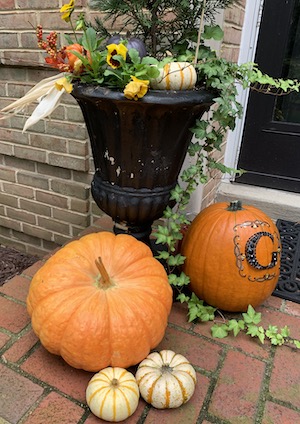 As we transition from summer to autumn, seasonal decorations begin to show up on neighborhood doorsteps and tabletops. Some of the most popular — pumpkins, chrysanthemums, gourds, Indian corn and straw flowers — dominate in colorful splendor for about eight weeks before being displaced for other holiday decorations. Rather than sending them to the trash can or compost heap at season’s end, you can extend their life into the new year. Here are some guidelines for making the most of these seasonal fall favorites.
As we transition from summer to autumn, seasonal decorations begin to show up on neighborhood doorsteps and tabletops. Some of the most popular — pumpkins, chrysanthemums, gourds, Indian corn and straw flowers — dominate in colorful splendor for about eight weeks before being displaced for other holiday decorations. Rather than sending them to the trash can or compost heap at season’s end, you can extend their life into the new year. Here are some guidelines for making the most of these seasonal fall favorites.
Pumpkins
Starting in September, the pumpkin is the most popular fall decoration through early December. Unknown to many is the fact that pumpkins can be cured and stored for up to six months extending the life of a seasonal favorite well into the winter and beyond. For store bought pumpkins, bathe the pumpkin in a solution of ten parts water and one part bleach, coat the exterior with petroleum jelly and rub off the excess with a soft cloth. If there are any gouges in the exterior of the pumpkin, repeat the application of the petroleum jelly one or two days later to get a good seal.
If you grow your own pumpkins, harvest when the plant stems have turned brown, cutting about 4 inches (10 cm) from the base of the squash. Do not carry the pumpkin by the stem as that will injure the soft tissue at the top of the plant. Store in a sunny dry space for two weeks. At the end of two weeks, turn the squash upside down and continue to store it for another two weeks. At the end of the month, coat the outside of the pumpkin with olive oil to harden or cure the skin. Move it to a dry storage area to rest and place it on a rack covered with newspaper until you are ready to use it for pies, bread, soup or casseroles.
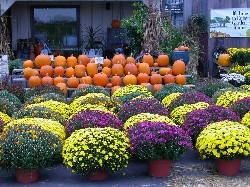 Chrysanthemums
Chrysanthemums
When purchasing seasonal “mums,” select plants that are the perennial varieties, Chrysanthemum x morifolium, rather than the annual, Chrysanthemum multicaule. Perennial Chrysanthemums have wide and deeply notched leaves, whereas annual leaves are strappy and thin. Deadhead the blossoms after the plant has finished blooming, determine where you want the plant to be in your garden and install it into a sunny garden spot with good drainage. Cut the stems back to 2 inches (5 cm) above the ground and insulate for winter with leaves or mulch. Watch your fall favorite emerge again in the spring.
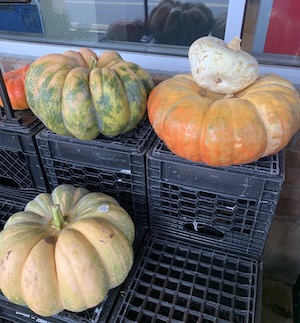 Gourds
Gourds
Coming from the genus Cucurbita, ornamental gourds have served as everyday tools for over a thousand years. Follow the same directions for preserving gourds as for store-bought pumpkins described above. Experts advise using twine or wire to hang the gourds from the ceiling to dry completely for two to three months. Unlike pumpkins, dried gourds can be stored in a cool, dry place and used again and again for several years. Large hard-skinned gourds from genus Lagenaria can also be recycled as birdhouses, bottles or food storage containers. When they are completely dried out, they can be carved, sanded and preserved with shellac or wax.
Indian Corn
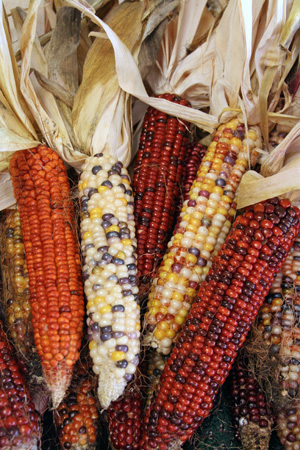 Another favorite for fall decorations is colorful ornamental corn often called Indian corn. Indian corn can be from the original heirloom varieties developed by Native Americans, but more often it is a common variegated corn called Flint corn, Zea Mays indudrante, or Dent corn, Zea Mays indentata. To prepare Indian corn for use in fall decorations, allow the ears to remain on the stalks until the husks are dried out and starting to turn brown. Remove ears from stalks and pull the husks back to allow the ears to cure in a warm, dry area for about a week. Once the ears are thoroughly dry, they can be used in outdoor decorations, wreaths and centerpieces. Indian corn also has miniature varieties that range in length from 2 to 5 inches (5 to 12 cm) long. Consider adding some tiny ears to an arrangement to create colorful points of interest. At the end of the fall season, remove the Indian corn from the arrangement and store boxed at room temperature in a dry, airy place to use again next year. If stored correctly, Indian corn will remain vibrantly colorful and can last for many years. As an alternative to storage, this season’s Flint corn can be ground into corn meal and Dent corn can be popped for popcorn.
Another favorite for fall decorations is colorful ornamental corn often called Indian corn. Indian corn can be from the original heirloom varieties developed by Native Americans, but more often it is a common variegated corn called Flint corn, Zea Mays indudrante, or Dent corn, Zea Mays indentata. To prepare Indian corn for use in fall decorations, allow the ears to remain on the stalks until the husks are dried out and starting to turn brown. Remove ears from stalks and pull the husks back to allow the ears to cure in a warm, dry area for about a week. Once the ears are thoroughly dry, they can be used in outdoor decorations, wreaths and centerpieces. Indian corn also has miniature varieties that range in length from 2 to 5 inches (5 to 12 cm) long. Consider adding some tiny ears to an arrangement to create colorful points of interest. At the end of the fall season, remove the Indian corn from the arrangement and store boxed at room temperature in a dry, airy place to use again next year. If stored correctly, Indian corn will remain vibrantly colorful and can last for many years. As an alternative to storage, this season’s Flint corn can be ground into corn meal and Dent corn can be popped for popcorn.
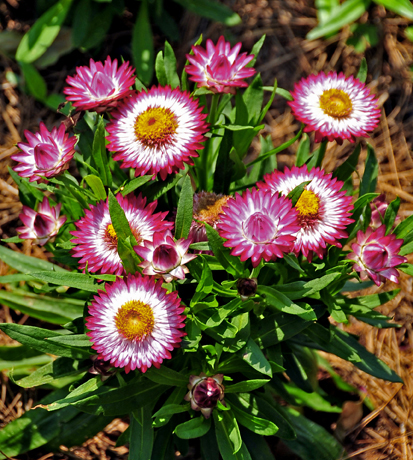
Straw flower
Straw Flowers
Many gardeners grow straw flowers, Xerochrysum bracteatum, for long lasting color and low maintenance. Often called, “everlasting flowers,” at season’s end, they find their way from garden beds into fall displays, wreaths and table arrangements. For dried flower arrangements or wreaths, cut the flowers as they begin to open, leaving 10 to 12 inches (25 to 30 cm) of stem per flower. Remove the leaves, bundle the stems into bunches of no more than 12 flowers with a rubber band, tie the bundles with string or twine and hang them upside down to dry in an airy, dry environment for about two weeks.
As a best practice for floral arrangements, another approach is to cut the flower heads from the stems leaving about 1 inch (2 cm) of stem and replace the stem with 6 to 10 inches (15 to 25 cm) of .22 grade florist wire. Bend a tiny hook at the top of the wire and insert it through the remaining stem into the flower head. Gently pull the wire back out of the blossom until the hook holds the flower head firmly in place. Dry on a block of Styrofoam or floral foam designed for dry flowers for two to three weeks in a cool, dry place. The straw flowers are now ready for displays or arrangements. At the end of the season, deconstruct the arrangement, remove the straw flowers and wrap in paper. Store in a closed box, such as a shoe box, in a dry location with low humidity. Punch some small holes in the box for air circulation. Carefully stored, the straw flowers should last for years.
… updated 2024
-
References
- Growing Pumpkins, Lewis Jett and Jodi Richmond, West Virginia University Extension
- Gourds, Mississippi State University Extension
- Chrysanthemums, Michael N. Dana and B. Rosie Lerner, Department of Horticulture, Purdue University Cooperative Extension Service
- Indian Corn, Susan Mahr, Wisconsin Master Gardener Program, Division of Extension, University of Wisconsin — Madison